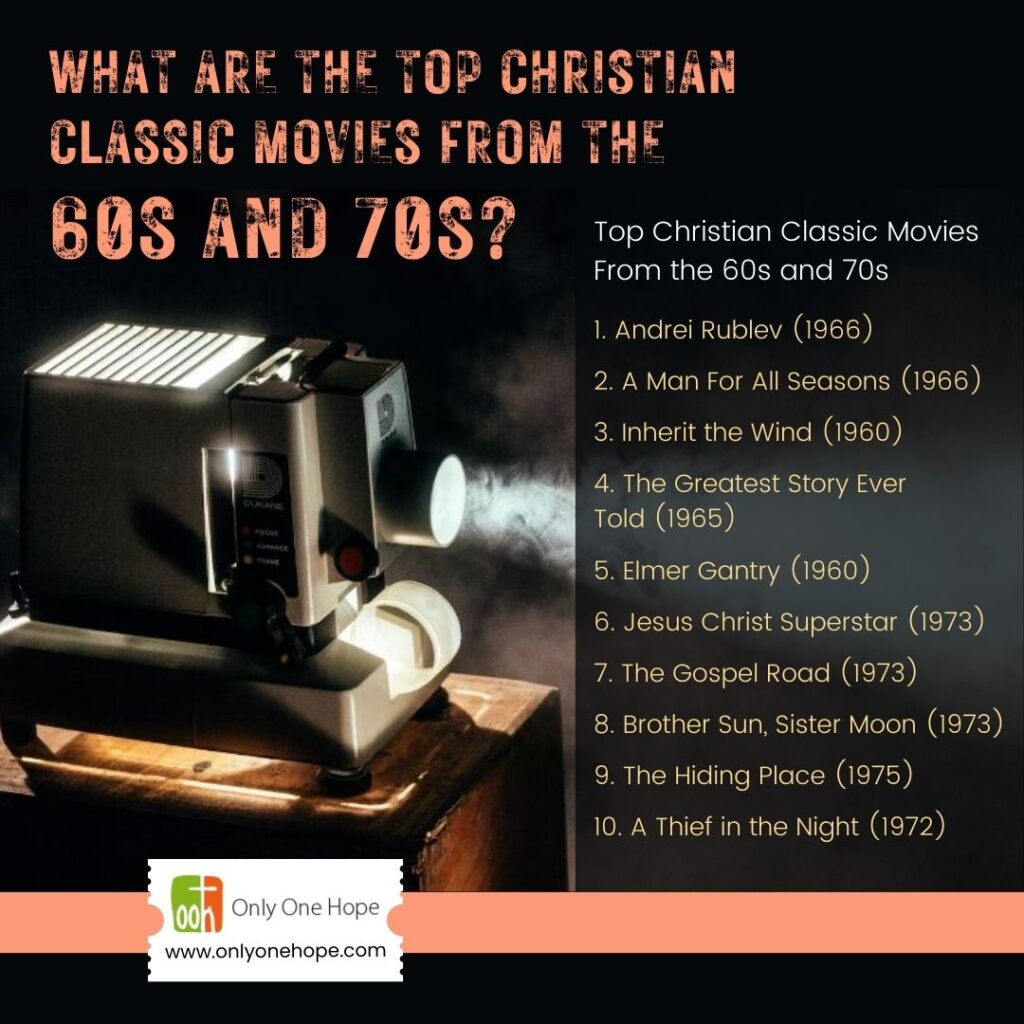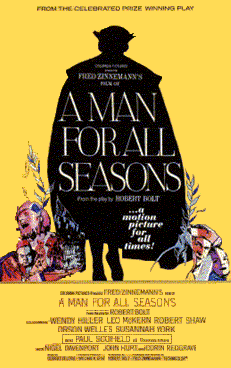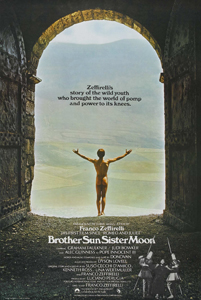Introduction
Welcome to a journey through time, as you explore the best Christian classic films from the enthralling 1960s to the soul-stirring 1970s. A few classic Christian films made their appearance during this period of cinematic acclaim, captivating audiences with their stirring messages of faith, atonement, and hope. As you travel back in time, you will come across cinematic treasures that have stood the test of time and continue to touch hearts. These films go beyond mere entertainment, delving deep into the human spirit and exploring profound themes such as love, sacrifice, and the eternal battle between good and evil.
This cinematic pilgrimage will take you to ancient biblical lands where courage and conviction change the course of history. You’ll meet charismatic people whose unwavering faith will inspire you to face life’s challenges with unwavering resolve. From moving dramas about the human condition to awe-inspiring epics about biblical stories, these Christian classics from the 1960s and 1970s speak to people of all ages and backgrounds, inviting you to reflect on your own beliefs and values.
So buckle up as you embark on this nostalgic journey to rediscover the timeless allure of Christian classics, which will remind you of the enduring power of faith and the indomitable human spirit. These films are a testament to cinema’s transformative power and the lasting impact of stories that touch people’s hearts.
Top Christian Classic Movies From the 60s and 70s
1. Andrei Rublev (1966)
Andrei Tarkovsky’s “Andrei Rublev” is a well-known historical drama film directed by him. It was released in 1966 and is regarded as one of cinema’s greatest masterpieces. The film is loosely based on the life of Andrei Rublev, a famous 15th-century Russian icon painter.
The film is set in medieval Russia during a time of political upheaval, social unrest, and religious strife. Through the life and experiences of the talented and introspective artist Andrei Rublev, it explores themes of art, faith, creativity, and the human condition. Also, it is notable for its poetic and philosophical approach to storytelling, as well as its mesmerizing cinematography and long, uninterrupted takes. Tarkovsky’s signature style, which includes slow-paced sequences and profound imagery, contributes to the meditative atmosphere of the film.
It’s worth noting that the original version of “Andrei Rublev” was heavily censored when it was first released in the Soviet Union, and only a heavily edited version was shown. Later, the complete and uncut version was restored and made available to audiences all over the world, garnering widespread acclaim and recognition. “Andrei Rublev” has left a lasting impression on the world of cinema and is still regarded as a work of cinematic artistry and storytelling brilliance. It is still a must-see for cinephiles and anyone interested in delving into the complexities of human nature through the lenses of art and history.
2. A Man For All Seasons (1966)
In 1966, Fred Zinnemann’s historical drama “A Man for All Seasons” was released in the United Kingdom. The film is based on Robert Bolt’s play of the same name. Six Academy Awards were eventually won by it, including Best Picture, Best Director for Fred Zinnemann, and Best Actor for Paul Scofield, who played the main role.
The movie tells the life story of Sir Thomas More, a humanist scholar, statesman, and lawyer who served as Lord Chancellor of England under King Henry VIII. The story, which takes place in the early 16th century, centers on More’s moral and ethical quandary as he declines to back King Henry VIII’s choice to divorce his wife, Catherine of Aragon, to wed Anne Boleyn. The conflict between More’s unwavering adherence to his values, loyalty to his conscience, and respect for the law, and the political pressure and demands of the King and the state, form the core of the movie. More faces severe repercussions for his disobedience as he refuses to speak out about Henry’s divorce and refuses to take the Oath of Supremacy, which would recognize the King as the supreme authority of the Church in England.
The book’s title, “A Man for All Seasons,” alludes to More’s steady and moral character, which remained unwavering in the face of difficulty and personal peril. The movie examines this historical figure’s character in-depth and raises issues of integrity, religious liberty, and the tension between political power and personal conscience. One of the best portrayals in movie history is considered to be Paul Scofield’s portrayal of Sir Thomas More. The film has established itself as a classic of British cinema and historical drama thanks to its elegant storytelling, excellent performances, and provocative themes.
3. Inherit the Wind (1960)
The 1960 American courtroom drama film “Inherit the Wind” was helmed by Stanley Kramer. The play by Jerome Lawrence and Robert E. Lee with the same name inspired the film. Despite being a fictionalized account, the Scopes Monkey Trial, a well-known court case that occurred in 1925, served as the play’s inspiration. The fictional town of Hillsboro, which is based in Dayton, Tennessee, the site of the Scopes Trial, is where the movie is set. It centers on Bertram Cates, a high school science teacher who is accused of breaking the law by introducing Charles Darwin’s theory of evolution to his students. Bertram Cates is portrayed by Dick York in the film. Matthew Harrison Brady (Fredric March), a well-known orator and three-time presidential candidate, is in charge of the prosecution and represents the government’s position on religious fundamentalism and the acceptance of a literal reading of the Bible.
Spencer Tracy’s Henry Drummond, a well-known defense lawyer and defender of civil liberties who supports the right to free speech and opposes the state’s anti-evolution law, is defending Cates in this case. The trial turns into a media spectacle that garners widespread attention and elicits heated discussions about the tension between science and religion, and the importance of education in forming public opinion.
The conflict between the ideas of academic freedom, the separation of church and state, and the right to free speech are powerfully explored in the book “Inherit the Wind”. The conflict between traditional religious beliefs and contemporary scientific discoveries is one of the film’s complex themes. Despite having a 1920s setting, the film’s themes and messages still hold today because of the ongoing discussions about evolution education and the place of religion in schools.
The film won praise from critics for its provocative subject matter, excellent performances, and effective direction. Spencer Tracy received an Academy Award nomination for Best Actor for his portrayal of Henry Drummond. “Inherit the Wind” continues to be a significant and enduring piece of American cinema, serving as a reminder to viewers of the value of protecting free thought and open discussion in society.
4. The Greatest Story Ever Told (1965)
American director George Stevens’ epic biblical film “The Greatest Story Ever Told” was released in 1965. Based on the New Testament of the Bible, the movie presents the life of Jesus. Several well-known actors who play a variety of characters from the Gospels make up the ensemble cast.
The film covers significant occasions in Jesus’ life, including his teachings, miracles, and pivotal moments from his ministry, from his conception to his crucifixion and resurrection. The movie examines the central ideas of Jesus’ life, such as sacrifice, love, and compassion. In addition to Charlton Heston as John the Baptist, Telly Savalas as Pontius Pilate, Sidney Poitier as Simon of Cyrene, and many others, Max von Sydow plays the role of Jesus Christ in the movie. The epic and reverent portrayal of Jesus’ life was the goal of the film, which had a large ensemble cast and a grandiose scope.
Upon its release, “The Greatest Story Ever Told” was met with mixed reviews. Some praised its lavish production and stellar performances, while others bemoaned its length and pacing. The film was a significant Hollywood event of its time due to its enormous budget and marketing efforts. Despite receiving mixed reviews from critics, “The Greatest Story Ever Told” is still regarded as a crucial film in the category of religious epics and is frequently shown and discussed, especially around holy days like Easter. The movie’s attempt to depict the life of Jesus grandly and reverently on the big screen has solidified its place in the annals of biblical movies.
5. Elmer Gantry (1960)
Richard Brooks’ 1960 drama film “Elmer Gantry” was produced in the United States. Sinclair Lewis’ 1927 novel of the same name, which went on to win the Pulitzer Prize for Fiction in 1928, served as the inspiration for the film.
Burt Lancaster plays Elmer Gantry, a charming and charismatic con man who develops into a successful and cunning evangelist, in the movie. The story takes place in the 1920s and centers on Gantry’s ascent to the top of the evangelical preacher world and his eventual fall because of his vices and dubious methods. Beginning as a fast-talking, promiscuous, and opportunistic salesman, Elmer Gantry ends up in Sister Sharon Falconer’s (Jean Simmons’) evangelical revival meeting. Gantry decides to join her religious cause after being inspired by her success and not out of genuine faith but rather to take advantage of the financial opportunities it offers.
Gantry develops into a skilled preacher using his aptitude for persuasion oratory, attracting sizable crowds and developing a following. He preaches religious virtue to the masses, but in reality, he maintains his moral corruption and engages in a variety of vices and hypocrisy. The movie explores the complexities of faith, the strength of manipulation, and the repercussions of using religious convictions for one’s benefit as the plot develops.
Burt Lancaster won the Academy Award for Best Actor for his portrayal of Elmer Gantry, and the movie was hailed for its incisive social commentary and stirring performances. It gained notoriety as a significant contribution to the body of movies that critique religious hypocrisy and the commodification of religion. A compelling examination of the darker sides of human nature, religious fervor, and the hazy boundaries between sincere faith and exploitation, “Elmer Gantry” is still regarded as a timeless classic.
6. Jesus Christ Superstar (1973)
Originally released in 1970 as a concept album, “Jesus Christ Superstar” has since been transformed into a stage production and a motion picture. Tim Rice wrote the lyrics to the music, which was written by Andrew Lloyd Webber. It chronicles the events of Jesus Christ’s final week, concentrating mainly on those that led up to his crucifixion. Judas Iscariot, Mary Magdalene, and Jesus himself all contribute their perspectives to the narrative.
A stage musical that made its Broadway debut in 1971 was developed as a result of the huge success of the concept album, which was released in 1970. The original Broadway performance was well-received by critics and went on to become a worldwide phenomenon.
Director Norman Jewison produced a movie version of “Jesus Christ Superstar” in 1973. In addition to Yvonne Elliman portraying Mary Magdalene, it featured Ted Neeley as Jesus and Carl Anderson as Judas Iscariot. The stage production was successfully transferred to the big screen by the movie, which expanded the musical’s audience and solidified its status as a cultural icon.
The innovative and exciting rock score of “Jesus Christ Superstar,” the potent performances, and the thought-provoking examination of the character’s motivations and emotions have all received praise. It has grown to be one of Tim Rice and Andrew Lloyd Webber’s most well-known pieces of art and is still a vital piece of the canon of musical theater. Many touring productions and revivals of “Jesus Christ Superstar” have been presented over the years, introducing new generations to its gripping narrative and music.
7. The Gospel Road (1973)
In 1973, the musical-drama movie “The Gospel Road” came out. It tells the story of Jesus Christ’s life, concentrating mainly on his ministry and the occasions leading up to his execution and resurrection. Johnny Cash, a well-known American singer-songwriter best known for his contributions to country, gospel, and rockabilly music, co-wrote, produced, and directed the movie.
The musical composition “The Gospel Road” features Johnny Cash performing songs and music alongside additional musicians and vocalists. Gospel and spiritual songs are included in the movie’s soundtrack to help illustrate Jesus’ teachings and the religious themes that surrounded his life.
Johnny Cash took a very personal interest in the project because it was a reflection of his Christian values. Through the use of music and film, he sought to bring the life of Jesus to the screen while expressing his viewpoint on the man and his teachings.
Even though “The Gospel Road” received mixed reviews when it was first released, its original method of retelling the life of Jesus through the prism of gospel and country music has made it a noteworthy cultural artifact. The movie is still a part of Johnny Cash’s legacy in the world of religiously-themed movies and Christian music as of my most recent update in September 2021.
8. Brother Sun, Sister Moon (1973)
A biographical drama movie called “Brother Sun, Sister Moon” was published in 1973. It was helmed by Italian director Franco Zeffirelli, who is renowned for his visually stunning and intensely moving movies. The well-known Catholic saint St. Francis of Assisi, who established the Franciscan Order, is profiled in the film.
The movie follows the life of St. Francis (played by Graham Faulkner), beginning with his youth as Giovanni and ending with his renown as St. Francis. The narrative delves into his spiritual awakening, his decision to reject his affluent upbringing in favor of a life of destitution, and his deep bond with animals and the natural world.
St. Francis is portrayed as a man of great faith and compassion who strives to live a simple life and love all living things by Jesus’ teachings. He establishes himself as a powerful spiritual figure and draws a group of devoted followers who share his ideal of leading a modest and compassionate life.
At the time of its debut, “Brother Sun, Sister Moon” was met with positive and negative reviews, with praise going to Riz Ortolani’s musical score and stunning visuals. The film’s themes of social justice, spirituality, and nature struck a chord with a wide audience, especially those who were influenced by St. Francis’s life and teachings.
As of September 2021, “Brother Sun, Sister Moon” is still regarded as a significant film in its depiction of St. Francis of Assisi’s life and is still beloved by viewers who are inspired by his extraordinary journey of faith and love.
9. The Hiding Place (1975)
The 1975 biographical drama film “The Hiding Place” is based on Corrie ten Boom’s autobiographical book of the same name. The true account of Dutchwoman Corrie ten Boom, who assisted her family in hiding Jewish refugees while the Netherlands was occupied by the Nazis in World War II, is depicted in the film.
Corrie ten Boom, played by Julie Harris, and her family, who are devout Christians living in Haarlem, the Netherlands, are followed throughout the movie. The Ten Boom family becomes actively involved in the Dutch underground resistance as the Nazis start to persecute and deport Jews, offering a haven for them and other Nazi hunters.
The Ten Boom family is ultimately betrayed by the Nazis and taken into custody. For their actions, they are sent to concentration camps, and the movie shows their struggles as they go through the Holocaust’s atrocities. The story’s main themes are Corrie’s faith and tenacity in the face of adversity.
The film “The Hiding Place” won praise from critics for its stirring depiction of bravery, faith, and the triumph of the human spirit even in the most trying circumstances. James F. Collier’s film continues to enjoy widespread acclaim for its heartwarming story and stirring performances. The bravery and selflessness of those who put themselves in danger to save others during the Holocaust are demonstrated by this.
Many people have been motivated by Corrie Ten Boom’s life and “The Hiding Place” because of its moving depiction of the resilience of the human spirit in the face of hardship.
10. A Thief in the Night (1972)
The 1972 Christian apocalyptic movie “A Thief in the Night” was helmed by Donald W. Thompson and produced by Russell S. Doughten. The film is a part of the “The Thief in the Night Series,” a group of films that also includes the sequels “A Distant Thunder” (1978), “Image of the Beast” (1980), and “The Prodigal Planet” (1983). The depiction of end-times events according to Christian eschatology is what makes the series famous as a whole.
Patty Myers, who is portrayed by Patty Dunning, is the main character of “A Thief in the Night”‘s story. Before a series of apocalyptic events known in Christian theology as the Rapture, Patty leads a relatively carefree and agnostic life. According to the doctrine of the rapture, Christians will be taken to heaven at the end of the world while unbelievers must endure the tribulation, a time of great upheaval on Earth.
Patty is left behind when the Rapture takes place, and the movie follows her journey as she deals with the repercussions of her disbelief and the realization that the end-times prophecies are coming true. Patty meets a group of Christians who are currently hiding out throughout the course of the movie, and they assist her in comprehending the significance of the events taking place all around them.
In the 1970s, “A Thief in the Night” became well-known among Christians for its portrayal of end-times events and its attempt to instill in its audience a sense of urgency and readiness. The religious themes and storytelling technique of the movie had a significant impact, igniting debates on the subject of the end times and the value of faith and steadfast adherence to one’s beliefs. The movie received mixed reviews from critics because of its low-budget production and occasionally divisive theology, but it has remained a significant cultural touchstone for some Christian communities. It has also been interpreted as a reflection of the intense interest in eschatology and end-times prophecy that developed at that time.
Conclusion
Finally, the 1960s and 1970s saw the birth of several iconic Christian classic films that have stood the test of time. These films depicted biblical stories with skill, explored themes of faith, redemption, and personal transformation, and demonstrated the strength of religious convictions in the face of adversity.
These Christian classic films from the 1960s and 1970s continue to captivate audiences around the world, transcending their original eras to inspire and enlighten new generations. They have become a part of the cultural and cinematic legacy through their storytelling and themes, leaving an indelible mark on the world of Christian-themed cinema. Their enduring relevance demonstrates the universal appeal of stories that explore the depth and power of human spirituality, as well as the eternal search for meaning and purpose in life.




